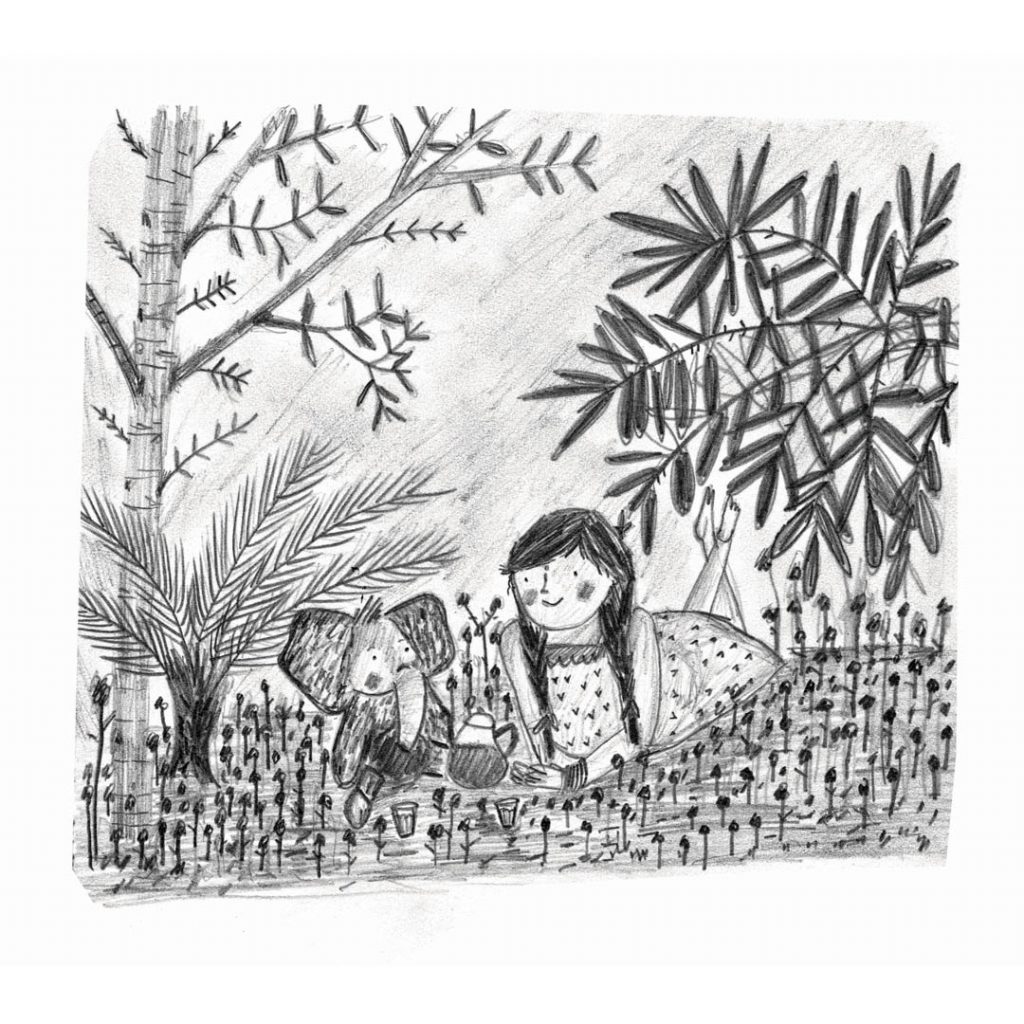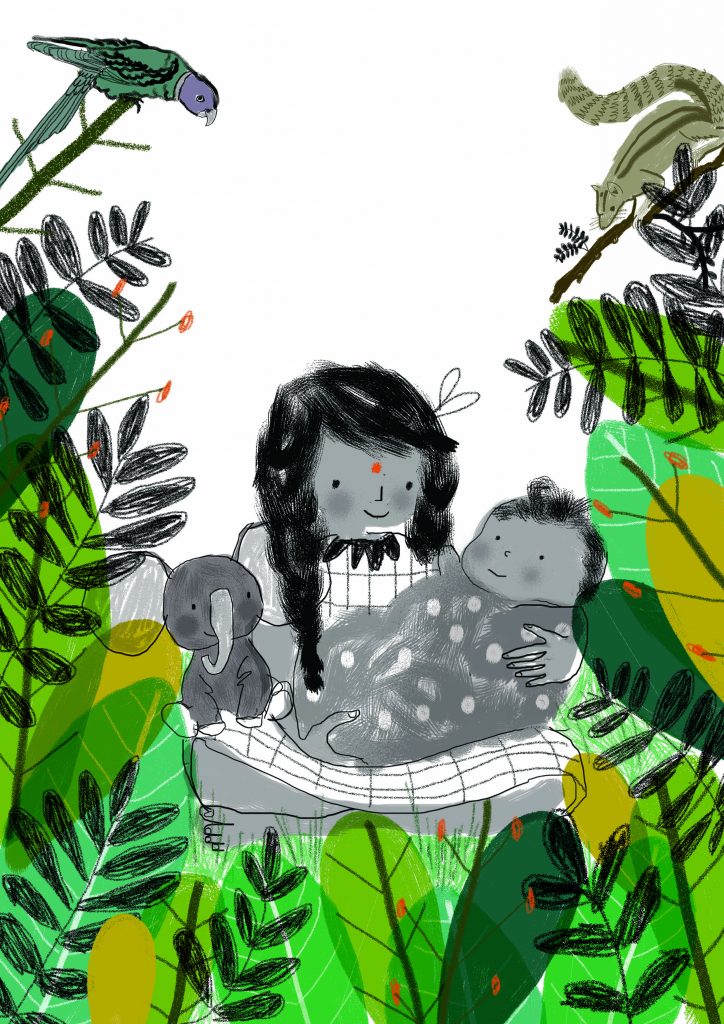
As the writer of the story, I’m always curious about illustrators go about their process of converting my story into pictures. Illustrations help understand the story especially when it’s set in a different community, city or culture.

Jen Khatun is the illustrator of Sona Sharma – Very Best Big Sister that came out in the UK in September 2016.
Here is my interview with Jen Khatun.
Did you always draw as a child?
Drawing has always been part of my life. As a child, I would always draw on the concrete slabs that were in the garden, and despite it getting me into trouble with my Amma, my parents saw that I really wanted to draw and be creative. And soon enough they bought me my very first colouring books, sketchbooks, pencils, felt-tips and colouring pencils. Luckily for my Amma, I had stopped colouring her garden stone slabs!
What were your favourite things to draw?
My favourite things to draw as a child were people and animals. I also really enjoyed drawing my favourite characters from books I loved reading, such as from Roald Dahl books.
Who inspired you to learn to draw?
My brother. He is super creative and his drawings were so realistic, it always bewildered me as a child. I really wanted to draw like him, and so I kept drawing.
I found that I could never draw things realistically as he did, that my style always had some obscurity, and it would pain me that I could never draw like him. But my brother always encouraged me that there was always something unique in my style and I should embrace it. And so I did, and I stopped being hard on myself and followed my style as it was.
Did anyone at home or school teach you or encourage you?
My family have always been my real encouragers. I respect them in every way, and I’m so proud to be part of them.
My late Appa always raved how I would one day be a ‘great wonderful artist’ as he would so put it. I returned to education after his passing, as a mature student to practice Illustration. I did it for him.
What materials do you use to draw? Do you use a computer for drawing too?
I have always used Pen and Ink, but since graduating and illustrating books, I have found that using a tablet and drawing things digitally have been extremely helpful.
If there are any re-edits of illustrations then I can easily open up the file on Photoshop and edit it within minutes, rather than drawing the whole illustration again with pen and ink.
But I always try and keep my fingertips soaked in black ink when I can, and draw with my fine nib pen. The sensation of drawing on paper and making the lines are sublime and irreplaceable.
Did you go to school to study art?
I studied BA Illustration at Southampton Solent University, and specialised in Children’s Illustration.
Did you learn different styles of drawing?
When I was at university, I learned different techniques such as Printmaking which I really enjoyed, and I even used this technique to illustrate my work.
But I really enjoyed the loose-ness you get from drawing with pen and ink, and stuck with what I felt worked best for me and my final year project.
How did you settle on a style for yourself?
I kept it simple and loose, and I didn’t mind if things didn’t make sense with proportion in my drawings.
I would aim to add charm into my characters with a few lines, scribbles, shade and dots, very much like my ultimate favourite Children’s Illustrator, Sir Quentin Blake.
Do you like B&W line drawings or drawings in colour?
I am happy to dabble in both, but I really enjoy drawing in black and white. It’s classic, it’s nostalgic and it allows the reader to imagine more.
Tell us about being an illustrator. How do you decide what to draw for a story?
Being a Children’s Book Illustrator has always been my dream since I was a child. Through hard work at college and University, I finally got the right opportunity to be represented by The Bright Agency Group after I graduated , and from there on, I was able to work on my portfolio, and with their professional guidance, it soon led to exciting book projects.
Having the title ‘Children’s Book Illustrator’ comes with a lot of responsibility and dedication. Each book, I take careful consideration and respect to meet requirements and deadlines, but also visually interpret the text which marries the writer’s words beautifully.
When I first begin to draw a story, I read the story twice.
- Once as a whole book, so I can feel the depth and the premise of the story-telling.
- And then when I begin to draw for the pages, I re-read each page again to really pick out the important words and the feelings I would like to emphasise specifically through my illustrations.
- I then begin to draw the main character many times to get the core of the story on the right page.

What are your hobbies? When you are not drawing for work, what do you do?
I love to read books, from children’s books to classic mysteries.
I love cooking and being in the kitchen, I get that trait from my Amma.
And I enjoy going for long country walks with my fiancé and my dog Juno.
Find fun facts about Jen here.
Can you give three tips to young artists who want to follow in your footsteps?
- Always believe in yourself, your style and your work, never compare yourself to others because we are all so unique.
- Structure your lifestyle and your work ethic- always have a ‘to-do list’ at hand, and manage a timetable for your work. This will really help you to meet deadlines when working with clients.
- Use your free time to make up for your own projects, like re-design a book cover or create some B/W vignettes for your favourite book? This will help build your portfolio, and the more variety of projects you have, the more exciting your portfolio will look to agencies and clients.
Don’t forget to download Jen’s drawing activity!


